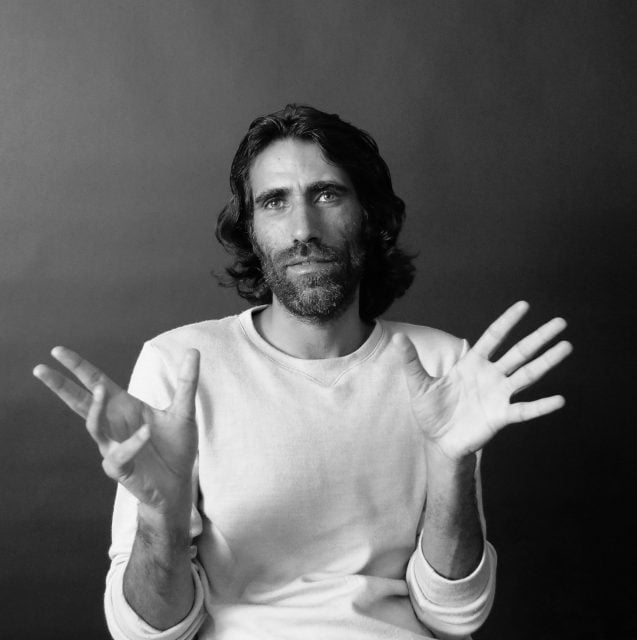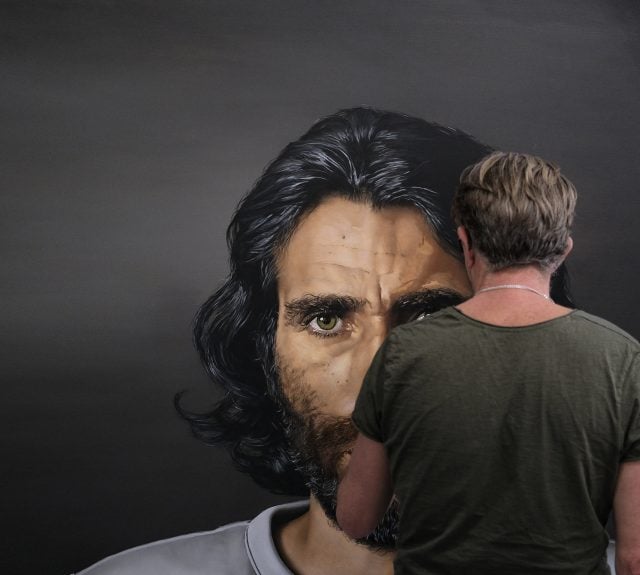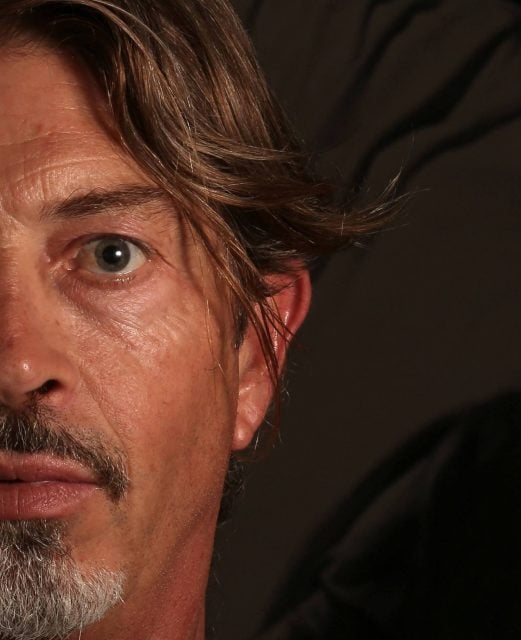
Lennox Head artist and film-maker Angus McDonald is officially a finalist in the 2020 Archibald Prize for his extraordinary portrait of refugee activist and author Behrouz Boochani.
Echonetdaily asked Mr McDonald how he originally got interested in human rights and refugee issues.
‘I first got involved in 2016 after I travelled to Greece to witness the response of local island communities to the massive numbers of asylum seeker arrivals who crossed the Mediterranean by boat in 2015-2016,’ he said.
‘One million people arrived into Greece in just fifteen months, most fleeing the Syrian conflict. I lived in Greece for the first six years out of art school and still had friendships there and they were passing on the stories to me.
‘The island I’d lived on, Leros, was one the of the places that experienced huge numbers of arrivals. So I went there first and travelled all over Greece to see the impact. After witnessing the compassion of local people, I decided to start creating film content as a way to highlight the conversely horrendous asylum seeker policy here that had been implemented in mid-2013.
‘That policy was dealing with just 3,000 people, a ridiculously small number by comparison. The film content eventually led to making a documentary about Manus Island that won several awards and qualified for the Oscars last year.’
Why did you decide to paint Behrouz?

‘I’ve known him since 2018 when he collaborated on that documentary I produced and directed about Manus,’ said Mr McDonald.
‘I had thought even then that I would like to paint his portrait at some stage, and he agreed to do it. However, it wasn’t until I arrived in NZ that I had the opportunity to go and visit him in person and get him to sit for me.
‘My first attempt to visit him on Manus in 2019 failed when the authorities in Port Moresby seized my passport, questioned me and escorted me to the first plane back to Australia.
‘But eventually we met and spending time with him was wonderful.’
Mr McDonald said Mr Boochani was happy to do the portrait, ‘he liked the idea’.
How did the portrait happen?
‘I stayed five days in NZ with Behrouz in February. I was guided in how to approach the painting by the conversations we had. I then photographed him extensively and painted the work in my studio when I got back to Australia.’
In terms of his artistic aims with the portrait, Mr McDonald said, ‘I decided to show him looking out, engaging the viewer as a confident, peaceful man who had survived an ordeal and was now free.
‘Behrouz is not a victim. Through his work he struggled for years against the government’s regime and their attempts to break and defeat him. They failed to defeat him. He is opening a new chapter now and looking forward as a free man.
‘I also hoped that the portrait could reveal him as an individual, as for many people, he is still considered a symbol of the activism against the policy and as a brilliant writer but few know who he is as a man.’

Mr McDonald said it was ‘wonderful’ working with Behrouz Boochani, who likes the resulting portrait.
‘He is an extraordinary and inspirational man; kind, generous and also very funny.’
Will New Zealand be a good place for him, do you think?
‘Behrouz says that he’s happy there – also – that in some areas, the landscape reminds him of Iran. He has experienced a warm welcome from New Zealanders and feels comfortable.
‘It’s a massive change after living though so many years of hardship and captivity.’
Are people in NZ more accepting of refugees?
‘They seem to be, yes,’ said Mr McDonald. ‘Both within the society and politically. NZ has for years offered to take 150 refugees and asylum seekers from either Manus and Nauru but the Australian federal government has continually refused to take it up.’
Echonetdaily asked if there are deeper cultural differences between Australia and NZ on the refugee issue, as well political differences.
Mr McDonald said, ‘I’m no expert on this but I think it’s both. Clearly the federal government here has supported a very inhumane and hard-line policy for seven years which has violated the human rights of those held both offshore and onshore. They also continue to argue for it. New Zealand has no such policy.
‘New Zealand is also less divided as a nation on these types of issues than we are and they also have a more welcoming culture in relation to people from diverse backgrounds. Their leader Jacinda Ardern also sends the right messages about supporting those who are seeking asylum, and the issue is less politicised in NZ than here.’
As both a painter and a film-maker, Mr McDonald is in a unique position to comment on the respective strengths and weaknesses of the two artistic forms in terms of effecting social change.
He said, ‘Both are strong mediums and have the potential to effect change in their own way. One advantage of film is that it is easier to reach many more people in many different places in order to spread the messages you have much further. Also, more people view films than have an interest in painting.
‘But every piece of creative energy that is directed into enacting change is worthwhile and can make a difference.’
Mr McDonald suggests art has a ‘massive’ role to play in activism, ‘but it’s important to understand that change is a long and difficult process and activism is a collective effort that is made by people across all fields and in many different ways working to effect social and cultural change together.
‘Art is a key part but only one part.’
How do you feel about this new portrait compared to your previous Archibald finalists?

This is Angus McDonald’s sixth time as a finalist.
He said, ‘I love the process of getting to know the sitter and every Archibald has been a brilliant experience, however this year’s has the most personal significance to me because of my relationship with Behrouz and my engagement in the issue of refugee policy.’
Mr McDonald said there are always some ‘very strong works’ amongst the finalists. ‘In general, there’s also a lot of disagreement about which works are good or not so good and that’s part of the Archibald.’
Echonetdaily asked what he hoped his portrait of Behrouz would achieve.
Mr McDonald said, ‘I hope it will continue to shine light on the importance of creating a more compassionate and humane approach in respect of how we treat those who arrive here fleeing persecution or conflict.
‘I also hope that it creates some perspective around just how important the contribution Behrouz had made through his art and work has been to the collective understanding of just how cruel and immoral this policy is.
‘He is an inspirational man and I hope the portrait will be a source of inspiration to people to think about the issue and take a more active position on caring about who we are as a country.’
How do you feel about refugee policy in Australia?
According to Mr McDonald, ‘What we are doing now places Australia in the unique position of being one of the cruellest liberal democratic nations on earth. Australia is a country of decent people; I believe that, and we also have a history of being a generous and welcoming country. This has changed radically since 2001.
‘Refugees are a highly politicised issue now and have been used for political gain at the expense of values of decency and fairness that we used to think were part of our national character. Australia is now an outlier internationally and our hard-line policies are shameful, indefensible and do not provide solutions.
‘However, many thousands of people are working hard in a range of areas to enact change and support refugees and asylum seekers – the needle is slowly being pushed in the right direction.’
Why Lennox Head?

Mr McDonald said he’s ‘almost a local’, having moved to the region in 2001 and to Lennox Head in 2003.
‘I love the whole region and Lennox in particular. It’s still a small town, the community is awesome, the beaches are beautiful. I like the space, the connection to nature and the diversity of people; such an awesome place to live.’
In terms of the future, Mr McDonald said there are ‘so many people’ he would love to paint.
The Chinese artist and activist Ai Weiwei is at the top of his list.
Returning to the subject of his current portrait, Mr McDonald said he didn’t think Behrouz Boochani’s increasing fame has changed him, but it has ‘made him busier!’
Australia’s premier prize for portraiture, the Archibald, has been a major part of the local cultural landscape since 1921. You can view this year’s finalists here.
The 2020 prize will be announced at the Art Gallery of NSW on 25 September. It carries a value of $100,000.




This is the winning entry. I predict it will!
Hi Catherine, yes indeed. And ProMO “I Stopped These” ScoNO should be the one made to make the prize presentation!
Intensity, intensity, and the intent of the propensity, it is there all behind the eyes.
What is Behrouz Boochani thinking in all seriousness from his unblinking eyes.
The tenseness of his face and ‘the look” draws the viewer in sizing you up in size
It is you he is looking at, searching for an answer from the moan of a refugee’s cries
His drilling look’s a painting, of past pain in waiting, so chilling it gives the blood a rise
His wounds are but past him, let us not cast him aside, this journalist and author so wise.
Angus McDonald takes his brush and paints him, his pain and his wisdom, oh what a prize.
Chap is clearly talented, though I don’t really get this realism in portraiture. Take a photo.
Photos are taken of landscapes and objects because they do not have human feelings.
They do not give off an attitude or traits that only humans can give.
What you say about the chap, chaffs in human understanding about understanding humans.
A photo is one dimentional. The greatest thing in art is about trying to gain depth of field, to make it three dimententional on a flat surface of a canvas.
Look at the painting, the round neck of the t-shirt. It actually has depth, the t-shirt actually does go around his neck to the the back, whereas the photo of his neckline does not have depth. It appears flat because it is flat.
It certainly is an award winning portrait. I hope it is successful. But mostly, I pray that it may soften our hard hearted Government.
Angus you have captured the ‘soul essence’ of Behrouz. That is the language that emanates from this remarkable painting you have created. Behrouz, via Art has held up the mirror to the Australian Nation. We display a total lack of compassion to Refugees, First Nation peoples and the structurally created ‘other’. Thank you for this reminder and may Art and Soul triumph.